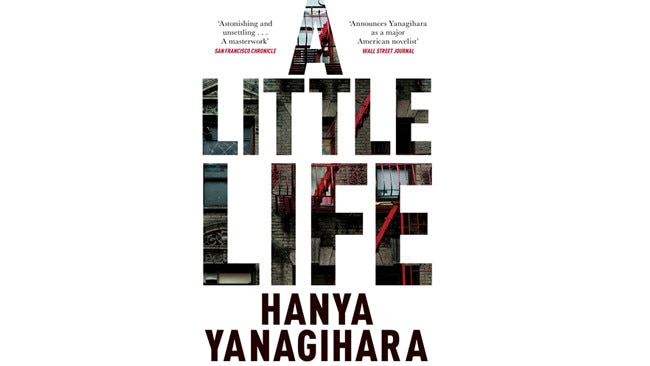Hanya Yanagihara’s disturbing new novel moves from abuser to abused
Hanya Yanagihara’s unflinching new novel tackles the devastating effects of abuse against a glamorous backdrop.

Hanya Yanagihara’s 2013 debut, The People in the Trees, was one of the most striking and most disturbing first novels to have appeared in some time. The story of Norton A. Perina, an immunologist whose extraordinary discoveries have been overshadowed by accusations of brutal and systematic sexual abuse of his adopted children, it was as notable for its assurance and cool control as for its forensic depiction of the psychology of the repugnant and self-regarding Perina.
In a crude sense Yanagihara’s new novel, the Man Booker Prize longlisted A Little Life, could be read as a sort of companion to The People in the Trees, a portrait of the psychology not of the perpetrator of abuse, but of the victim, and the devastating effects of such abuse.
Set in New York and spanning more than 40 years, it focuses on four friends: crippled mathematician and lawyer Jude St Francis, actor Willem Ragnarsson, wealthy architect Malcolm Irvine and painter and son of Haitian immigrants Jean-Baptiste, or JB as he is known. At first these four have almost equal billing, the narrative shifting fluidly between them as it depicts their efforts to make names for themselves in the city, a process that sees each enjoy multiplying success in their chosen field.
Although initially Yanagihara is finely tuned to the question of money and the degree to which it drives and constrains the choices the four make, there is something oddly blithe about the novel’s depiction of this process, a sense it is somehow preordained that all will succeed brilliantly, accruing fame and wealth with startling effortlessness.
In this respect A Little Life owes more than a little to novels such as Donna Tartt’s The Secret History and The Goldfinch (albeit without the faux-Dickensian trappings of the latter), both of which enjoin the reader in a particular set of fantasies about wealth and privilege (the adolescent nature of these fantasies is further underlined by the constant references to Jude and Willem’s beauty and specialness, the way they are always at the centre of their social worlds). It’s a quality that’s underscored by the novel’s curious elision of historical detail and deliberate lack of reference to events such as 9/11, a technique that suspends it in an eternal now and severs its portrait of the lives of the rich and famous from the complexities of historical reality.
Yet as the novel proceeds, and its focus begins to narrow, concentrating more and more on Willem and Jude, it complicates this tendency by allowing another, much more troubling reality to intrude. At first this reality remains unstated, implicit in the unsubtly named Jude’s silence about his past and the circumstances of the injuries that have permanently damaged his legs and back, but gradually it becomes clear these injuries are the visible manifestation of a childhood disfigured by appalling abuse.
The mismatch between the glittering lives of the central quartet and Jude’s hidden history is made more unsettling by the novel’s curious register, the degree to which the combination of distance and intensity that distinguishes Yanagihara’s writing allows her to depict the horror of Jude’s experiences in a way that episodes of him self-harming, or being raped and beaten, are almost of a piece with the parties of his later life.
Perhaps not surprisingly the result is more than a little disquieting, not least because the novel is so unflinching about the intractability of Jude’s psychic injuries. For while there are certainly moments when Jude’s psychology can seem a little over-determined, Yanagihara also resists the false catharsis that inheres in most narratives of recovery, demanding the reader engage with the totality of his suffering in a way that feels genuinely new and confronting.
Yet simultaneously there is something slightly uneasy about A Little Life’s treatment of its subject, a sense in which it is, if not quite exploitative, then certainly a little manipulative. The issue isn’t that the horrors inflicted on Jude are so relentless and extreme, although they are, it’s the contrast between the dislocation and deprivation of his childhood and the glittering, beautiful lives he and his friends build for themselves in New York.
This contrast gives rise to practical questions (is it really plausible a child treated the way Jude has been would be able to excel the way he does?) but it also lends the depravity Jude endures the same edge of fantasy that attaches to the image of Willem and the others gliding from one glamorous moment to another.
More deeply, though, it’s difficult not to feel the novel’s representation of Jude’s suffering occasionally shades into a sort of kitsch, in which extremity becomes an end in itself. Certainly in the book’s final sections, when Jude is progressively brutalised in new and ever more inventive ways, it feels less like keeping faith with the truth of his experiences and more like the sort of cosmic cruelty Thomas Hardy dishes out to his namesake in Jude the Obscure.
Interestingly — and I suspect significantly — a similar sort of overstatement mars the final pages of The People in the Trees, suggesting perhaps that this insistence we experience the extremity of suffering in all its blank, unprocessable awfulness is integral to Yanagihara’s fictional method. And while the reservations this overstatement engenders are more pervasive in A Little Life than in The People in the Trees, they nonetheless do not detract from the book’s larger sweep and complexity, its absorbing strangeness or, perhaps most importantly, the sheer ambition of its project.
James Bradley’s most recent novel is Clade.
A Little Life
By Hanya Yanagihara
Picador, 736pp, $32.99



To join the conversation, please log in. Don't have an account? Register
Join the conversation, you are commenting as Logout